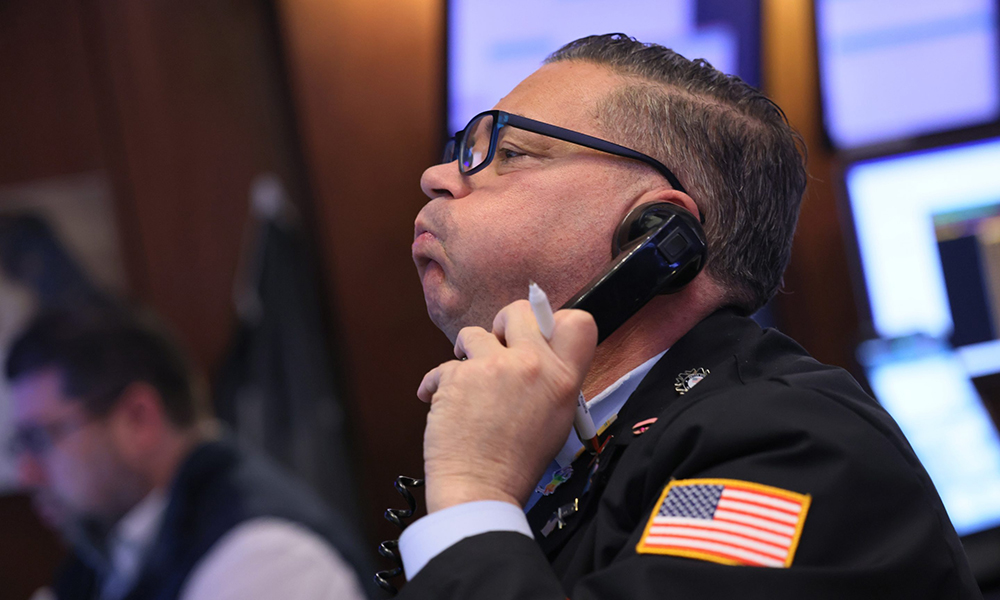有些迹象表明,美国经济又要衰退了

虽然近几个月甚至是近几年来,美国不时有顶尖的经济学家和华尔街的首席执行官预测美国经济即将发生衰退,但美国消费者硬是凭着强大的购买力让他们的预测一次又一次落空。尽管美国面临着近40年来最严重的恶性通胀,甚至为此不得不连续加息,但消费者并没有因此而捂紧钱袋子,美国经济也因为国内消费的活跃而仍然保持坚挺。但是上周的一些不容乐观的经济数据却让部分专家认为,这次衰退可能真的要来了。
首先是继向下修正了1月的零售业销售数据后,美国2月的零售业销售数据继续呈现疲软势头。这表明在持续两年的高通胀和轮番加息的轰炸下,消费者的购买力已经呈现疲态。Federated Hermes公司的投资经理达米安·麦金太尔通过电子邮件对《财富》杂志表示:“上个月的零售业数据下滑或许可以归咎于天气原因,但是本月的销售数据疲软则表明消费者的购买力可能并没有想象的那么健康。”
与此同时,美国在3月14日发布的2月生产者价格指数(PPI)也再度高于华尔街的预期。PPI一般会带动消费者价格指数(CPI)的上涨,因此很多投资者翘首以盼的降息或许不会很快发生了,尤其是美联储(Federal Reserve)的官员已经明确指出,在通胀得到充分控制之前,美联储不打算降息。LPL Financial公司的首席全球策略师昆西·克劳斯比称:“对于看重数据的美联储来说,这份报告对降息显然没有任何帮助。”
如果光分析零售业销售数据和PPI这两个指标本身,你就会发现,它们对整体经济而言并非什么可怕的信号——零售业销量还远远谈不上崩溃,PPI的涨幅也不算很厉害,但其中表现出来的趋势却是值得担忧的。如果PPI继续上涨,企业很可能就会把上涨的成本转嫁给消费者。那么早已在高通胀下不堪重负的消费者很可能会就势“躺平”,不再积极消费,美国经济或将就此无可抑制地滑下衰退的深渊。
不利迹象一:PPI上涨
美国劳工部(Labor Department)的劳工统计局(Bureau of Labor Statistics)于3月14日发布的美国PPI是一个特别值得关注的指标,因为PPI的上涨最容易对整体经济造成冲击。PPI反映了美国国内企业生产成本的变化,2月美国的PPI上涨了0.6%,高于经济学家们普遍预测的0.3%。
美国2月的PPI也同比增长了1.6%,不过这远低于2023年1月4.7%的同比增幅(当时美国的通胀率依旧高达6%)。虽然今年1月的PPI同比增长率貌似不高,但我们在此再次强调,需要关注的是它反映出来的趋势。自2023年10月以来,美国的PPI同比增长率一直保持在1.1%以下,到今年1月也仅有1%。但2月的PPI却显然迈向了一个不容乐观的方向。
今年2月,美国的能源价格上涨了4.4%,这是推动PPI上涨的一个重要因素。2023年美国整体通胀水平下降的一个重要原因是商品通胀的下降。不过花旗银行(Citi)的经济学家维罗妮卡·克拉克认为,2月的美国PPI数据显然表明,“美国商品价格的反通胀趋势基本上已经接近尾声了。”
由于抑制通胀的力量消失了,很多投资者期待已久的降息很可能又要被搁置,除非接下来即将发布的CPI较为给力。Commonwealth Financial Network公司的高级股票策略师罗布·斯万克表示:“总的来说,这可能会导致美联储在接下来的几次会议上继续搁置降息问题。”
不利迹象二:零售业销量疲软
随着PPI的上涨,2月美国的零售业销售数据弱于预期,这也给美国整体经济带来了狠狠一击。
根据美国人口调查局(Census Bureau)在3月14日公布的数据,今年2月,美国的零售业销售额环比仅增长0.6%,同比仅增长1.5%,低于经济学家普遍预测的环比增长0.8%。尽管汽油价格有所上涨,各大汽车厂商也采取了各种促销措施吸引消费者购车,但数据显示,消费者还是捂紧了钱袋子。
Bankrate公司的高级行业分析师泰德·罗斯曼在3月14日通过电子邮件指出:“1.5%的同比增长率是不值一提的,甚至还不到整体CPI涨幅的一半。换句话说,零售业的销售数据已经滞后于通胀数据了。对零售商而言,经济已经进入一个缓慢增长阶段,只有电商、餐饮、酒吧等行业的年度增长数据高于总体通胀数据。”
除了2月的零售业销售数据弱于预期,1月的零售业销售数据的同比涨幅也从之前的-0.8%修正为-1.1%。这也标志着此前公布的PPI指数连续四个月需要下调。
LPL Financial公司的首席经济学家杰弗里·罗奇通过电子邮件告诉《财富》杂志:“这些经济指标连续数月进行向下修正,恰恰说明了经济增长正在放缓。”尽管目前美国的失业率仍旧维持在低位,消费者也还有一些消费能力,但经济下行的大趋势已经显现出来。
在这两个不利迹象接连出现后,有哪些严重后果是投资者们最应该担心的?首先是信用卡违约问题值得关注,今年美国的信用卡债务已经再创历史新高。另外罗奇指出:“接下来几个月,汽车销量也是一个值得关注的指标。如果美国经济确实进入下行阶段,那么预计汽车库存就会大幅增加,经销商也会出台更多的促销措施。”(财富中文网)
译者:朴成奎
虽然近几个月甚至是近几年来,美国不时有顶尖的经济学家和华尔街的首席执行官预测美国经济即将发生衰退,但美国消费者硬是凭着强大的购买力让他们的预测一次又一次落空。尽管美国面临着近40年来最严重的恶性通胀,甚至为此不得不连续加息,但消费者并没有因此而捂紧钱袋子,美国经济也因为国内消费的活跃而仍然保持坚挺。但是上周的一些不容乐观的经济数据却让部分专家认为,这次衰退可能真的要来了。
首先是继向下修正了1月的零售业销售数据后,美国2月的零售业销售数据继续呈现疲软势头。这表明在持续两年的高通胀和轮番加息的轰炸下,消费者的购买力已经呈现疲态。Federated Hermes公司的投资经理达米安·麦金太尔通过电子邮件对《财富》杂志表示:“上个月的零售业数据下滑或许可以归咎于天气原因,但是本月的销售数据疲软则表明消费者的购买力可能并没有想象的那么健康。”
与此同时,美国在3月14日发布的2月生产者价格指数(PPI)也再度高于华尔街的预期。PPI一般会带动消费者价格指数(CPI)的上涨,因此很多投资者翘首以盼的降息或许不会很快发生了,尤其是美联储(Federal Reserve)的官员已经明确指出,在通胀得到充分控制之前,美联储不打算降息。LPL Financial公司的首席全球策略师昆西·克劳斯比称:“对于看重数据的美联储来说,这份报告对降息显然没有任何帮助。”
如果光分析零售业销售数据和PPI这两个指标本身,你就会发现,它们对整体经济而言并非什么可怕的信号——零售业销量还远远谈不上崩溃,PPI的涨幅也不算很厉害,但其中表现出来的趋势却是值得担忧的。如果PPI继续上涨,企业很可能就会把上涨的成本转嫁给消费者。那么早已在高通胀下不堪重负的消费者很可能会就势“躺平”,不再积极消费,美国经济或将就此无可抑制地滑下衰退的深渊。
不利迹象一:PPI上涨
美国劳工部(Labor Department)的劳工统计局(Bureau of Labor Statistics)于3月14日发布的美国PPI是一个特别值得关注的指标,因为PPI的上涨最容易对整体经济造成冲击。PPI反映了美国国内企业生产成本的变化,2月美国的PPI上涨了0.6%,高于经济学家们普遍预测的0.3%。
美国2月的PPI也同比增长了1.6%,不过这远低于2023年1月4.7%的同比增幅(当时美国的通胀率依旧高达6%)。虽然今年1月的PPI同比增长率貌似不高,但我们在此再次强调,需要关注的是它反映出来的趋势。自2023年10月以来,美国的PPI同比增长率一直保持在1.1%以下,到今年1月也仅有1%。但2月的PPI却显然迈向了一个不容乐观的方向。
今年2月,美国的能源价格上涨了4.4%,这是推动PPI上涨的一个重要因素。2023年美国整体通胀水平下降的一个重要原因是商品通胀的下降。不过花旗银行(Citi)的经济学家维罗妮卡·克拉克认为,2月的美国PPI数据显然表明,“美国商品价格的反通胀趋势基本上已经接近尾声了。”
由于抑制通胀的力量消失了,很多投资者期待已久的降息很可能又要被搁置,除非接下来即将发布的CPI较为给力。Commonwealth Financial Network公司的高级股票策略师罗布·斯万克表示:“总的来说,这可能会导致美联储在接下来的几次会议上继续搁置降息问题。”
不利迹象二:零售业销量疲软
随着PPI的上涨,2月美国的零售业销售数据弱于预期,这也给美国整体经济带来了狠狠一击。
根据美国人口调查局(Census Bureau)在3月14日公布的数据,今年2月,美国的零售业销售额环比仅增长0.6%,同比仅增长1.5%,低于经济学家普遍预测的环比增长0.8%。尽管汽油价格有所上涨,各大汽车厂商也采取了各种促销措施吸引消费者购车,但数据显示,消费者还是捂紧了钱袋子。
Bankrate公司的高级行业分析师泰德·罗斯曼在3月14日通过电子邮件指出:“1.5%的同比增长率是不值一提的,甚至还不到整体CPI涨幅的一半。换句话说,零售业的销售数据已经滞后于通胀数据了。对零售商而言,经济已经进入一个缓慢增长阶段,只有电商、餐饮、酒吧等行业的年度增长数据高于总体通胀数据。”
除了2月的零售业销售数据弱于预期,1月的零售业销售数据的同比涨幅也从之前的-0.8%修正为-1.1%。这也标志着此前公布的PPI指数连续四个月需要下调。
LPL Financial公司的首席经济学家杰弗里·罗奇通过电子邮件告诉《财富》杂志:“这些经济指标连续数月进行向下修正,恰恰说明了经济增长正在放缓。”尽管目前美国的失业率仍旧维持在低位,消费者也还有一些消费能力,但经济下行的大趋势已经显现出来。
在这两个不利迹象接连出现后,有哪些严重后果是投资者们最应该担心的?首先是信用卡违约问题值得关注,今年美国的信用卡债务已经再创历史新高。另外罗奇指出:“接下来几个月,汽车销量也是一个值得关注的指标。如果美国经济确实进入下行阶段,那么预计汽车库存就会大幅增加,经销商也会出台更多的促销措施。”(财富中文网)
译者:朴成奎
The mighty American consumer has shrugged off months, even years of recession predictions from top economists and Wall Street CEOs. Facing the hottest inflation in 40 years, and aggressive interest rate hikes meant to tame it, consumers have managed to continue spending, enabling the economy to remain on solid footing. But last week, a one-two punch of bad economic data has some experts waiting for another uppercut.
The second straight weak retail sales report, which included a downward revision of January’s sales data, has sparked concerns that consumers are finally showing signs of wear and tear after powering through price increases and rising borrowing costs for roughly two years. “While last month’s retail sales miss was chalked up to weather, this month’s weakness suggests that perhaps the consumer is not as healthy as expected,” Damian McIntyre, portfolio manager at Federated Hermes, told Fortune in emailed comments.
At the same time, producer price inflation, which tends to lead consumer price inflation, also came in above Wall Street’s expectations for the second straight month on March 14. It’s another piece of data that could put investors’ dreams of swift, economy-boosting interest rate cuts on hold, particularly with Fed officials being very clear that they don’t plan on cutting rates until inflation is well under control. As Quincy Krosby, chief global strategist for LPL Financial, put it: “For the data dependent Fed, this report isn’t helpful.”
The latest retail sales and producer price inflation reports aren’t dire news for the economy in their own right—retail sales are far from outright collapsing, and producer price inflation isn’t soaring—but the new trends seen in them are concerning. If businesses continue to see price hikes, they’ll likely pass those on to already inflation-weary consumers. That could put a stopper on consumers’ aggressive spending, which has helped prevent a U.S. recession so far.
The Jab: Rising Producer Prices
The quick jab that hit the economy first on March 14 was an elevated producer price inflation reading. The producer price index (PPI), which measures the change in the prices domestic sellers pay, rose 0.6% last month, the Labor Department’s Bureau of Labor Statistics reported on March 14. That was compared to economists’ consensus forecast for 0.3%.
Year-over-year, producer prices also jumped 1.6% in February. That’s well below the 4.7% year-over-year rise in producer prices seen in February 2023, when inflation was still at 6%, but once again it’s the trend that’s concerning. After sticking at or below 1.1% since October, including just 1% in January, February’s PPI inflation data is a step in the wrong direction.
Producers’ inflation was largely driven by a 4.4% spike in energy prices in February that caused overall goods prices to rise. Falling goods inflation has been one of the keys to the drop in overall U.S. inflation over the past year, but for Citi economist Veronica Clark, the PPI report is evidence that “the disinflation in goods prices is largely coming to an end.”
The end of goods disinflation is apt to put interest rate cuts, which many investors were expecting to see this month not long ago, on hold unless upcoming consumer price inflation reports prove more favorable. “Overall…this likely continues to provide support for the Fed remaining on pause for the next few meetings,” Rob Swanke, senior equity strategist for Commonwealth Financial Network, said.
The Cross: Weak Retail Sales
After being touched up by a producer price index jab, the economy was hit with a serious right cross from a weaker-than-expected retail sales report.
Retail sales rose just 0.6% month-over-month and 1.5% from a year ago in February, the Census Bureau reported on March 14. That’s compared to economists’ consensus forecast for an 0.8% monthly rise in sales. Even with rising gas prices and car dealer incentives driving more spending, the data shows consumers are beginning to rein in their budgets.
“The 1.5% year-over-year gain is minimal and less than half of the headline CPI number. In other words, retail sales are lagging inflation,” Ted Rossman, senior industry analyst at Bankrate, told reporters in emailed comments on March 14. “It’s a slow-growth economy for retailers, with only e-commerce shops and bars and restaurants posting annual growth figures above the overall rate of inflation.”
On top of the slower than forecast February data, last month’s year-over-year sales figures were revised down from negative 0.8% to negative 1.1%. That marks the fourth consecutive month previous producer inflation data was revised lower.
Jeffrey Roach, chief economist at LPL Financial, told Fortune via email that the “consistent downward revisions should tell us the economy is slowing,” even if the consumer still has some capacity to spend with the unemployment rate remaining low.
What should investors fearing a knockout follow-up punch to the latest one-two be looking for? Credit card delinquencies are one area of concern, with credit card debt reaching a record high this year. But Roach had another idea: “A helpful indicator to watch in the coming months is auto sales. If the economy is truly slowing, expect to see vehicle inventories swell and dealers offer more incentives,” he said.













